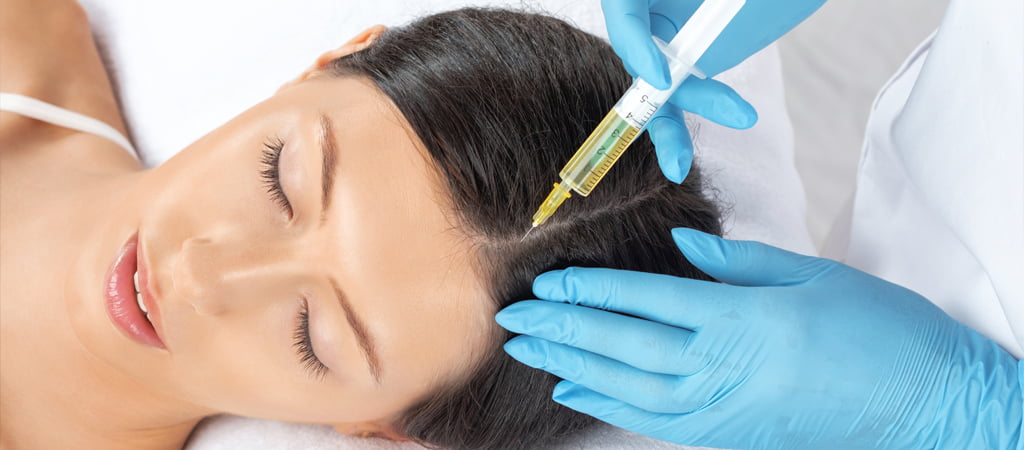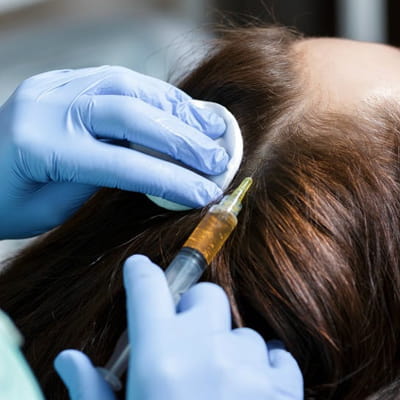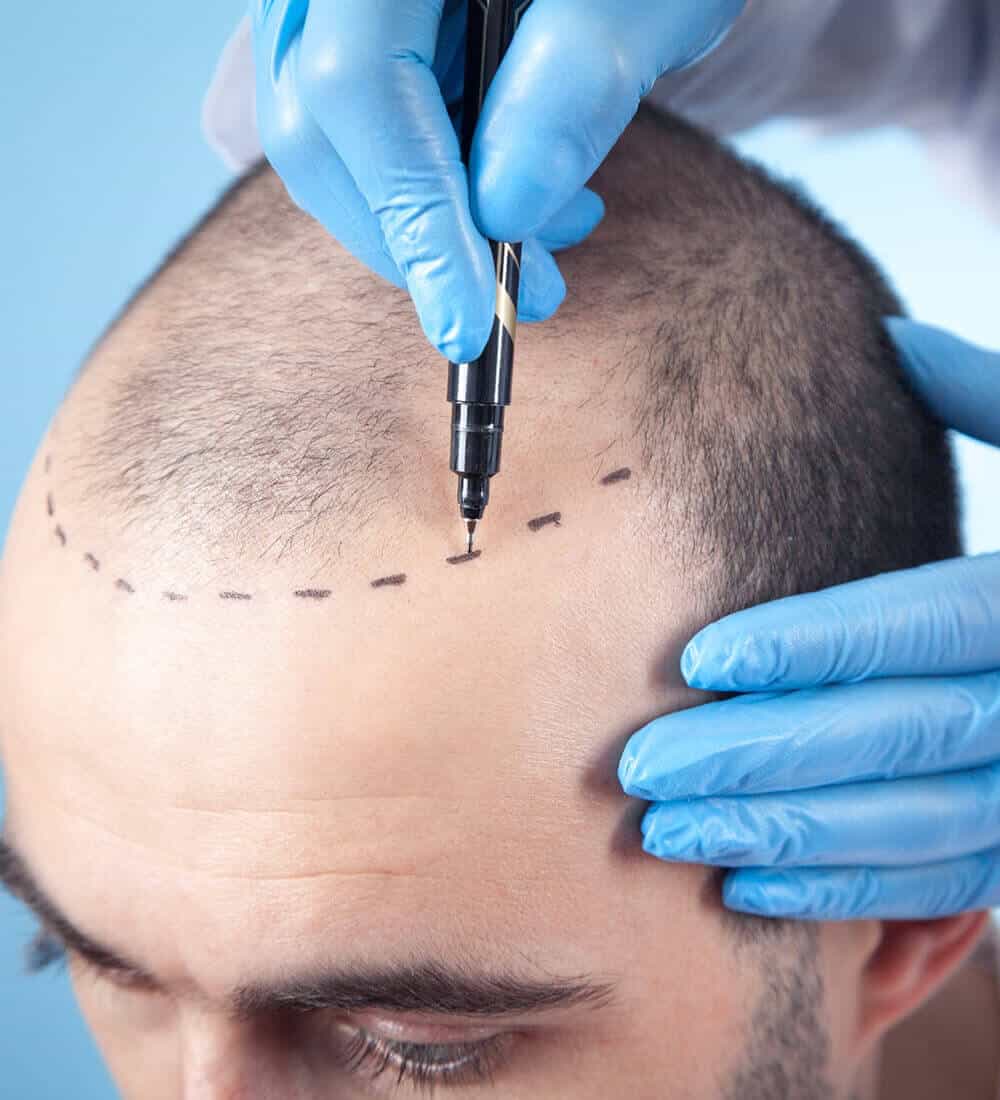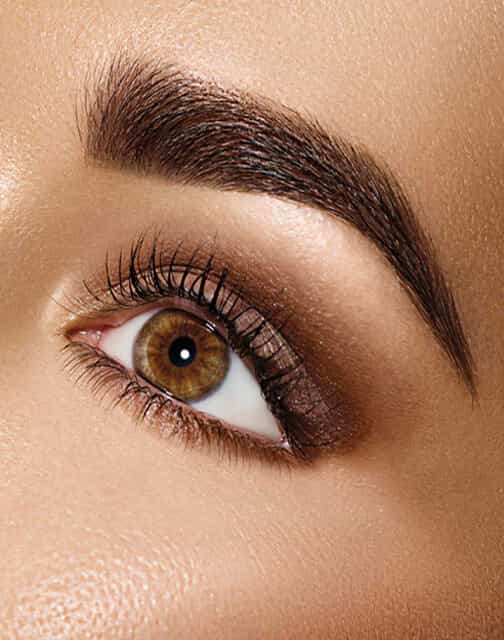What is Hair Mesotherapy and Hair PRP?

Hair Treatments: Hair Mesotherapy and PRP (Platelet-rich plasma) are supportive treatments for the hair to help regenerate the scalp, strengthen the hair and hair follicle, improve hair quality, make it more vibrant and strong and prevent hair loss. Individuals who have experienced hair loss due to weakened hair, stopped hair growth due to trauma and those who want to strengthen the hair structure after transplantation can find benefits in these treatments. This type of treatment requires repeated sessions and can be applied to men and women. It not only enables hair to grow in the shedding areas, but also helps the strengthening and durability of the hair.

Hair Mesotherapy
Hair mesotherapy is one of the hair treatments that uses serums as a method. The serums containing vitamins, minerals and nutrients are injected into the lower part of the scalp where there is hair loss in both male and females.
The treatment’s aim is to support the hair and strengthen the hair in sparse areas, to slow down and essentially stop hair loss, by using techniques for regeneration by stimulating hair follicles. The application is done under the skin with the help of an injector. The procedure takes approximately 15-20 minutes and usually requires a repeat session every 2 weeks.
Conditions In Which Hair Mesotherapy Should Be Applied?
Hair mesotherapy can be applied in the following cases to prevent hair loss
- Weakened hair and hair loss.
- Intense hair loss after pregnancy.
- Male type (androgenic) and genetic thinning and hair loss
- Eliminating dryness and dandruff problems on the scalp
Hair PRP

Hair PRP is the process of taking blood from the patient, separating the plasma and injecting it into the problematic area with the help of an injection. The plasma obtained by this method is very rich in platelets.
The application aims to repair hair follicles, help cell renewal, boost the growth of healthy cells, and repair the scalp.
As hair follicles are directly related to the scalp, hair loss is prevented in two folds, by strengthening the hair and eliminating the scalp problems. This treatment allows for the hair and hair follicles to be nourished organically. PRP is used in many other health problems in the field of skin, gynecology, orthopedics and hair loss.
In Which Situations Can PRP Be Applied?
- Renewal of hair and the scalp to ogive vitality, flexibility and shine.
- Strengthening weakened hair and preventing hair loss.
- Treatment of wrinkles.
- Skin replenishment for skin problems such as scars and cracks
- It can be treated by increasing tissue quality in cases such as thinning of the skin and burning after other treatments like laser procedures,
- Rejuvenation of the face, hands and arms, inner legs, neck and décolleté area in medical aesthetics
- In early tendon and muscle injuries
- Muscle and joint pain
- In early knee arthritis
- Meniscus and cartilage damage
It should be noted that PRP is not a stand-alone treatment, but a supportive application.
Who Are Hair Treatments Suitable For?
This type of treatment is generally suitable for individuals experiencing excessive hair loss, problematic scalp, and hair sparseness.
Cases involving ringworms, eczema, psoriasis will need to be treated before a hair treatment application. Treatments that are applied on the scalp including chemotherapy and radiology, will need to be complete before starting a hair treatment.
If hair loss and/or thinning is due to other illnesses or the use of medication, the physician’s approval is required for the application.
How Are The Hair Treatments Applied?
Hair treatment application is determined based on which method (PRP, Mesotherapy) the person is suitable for. In a consultation, the physician will decide the treatment, create the plan, and assess the number of sessions that will be required Applications according to the methods are as follows:
Mesotherapy Application;
This method involves the injection of serums containing vitamins, minerals and components that nourish hair follicles injected into the patients scalp. The serum content is decided according to the needs of the patient. B group vitamins in particular, zinc, copper, hyaluronic acid, amino acids, coenzymes, growth factors and other drugs are frequently used for this purpose.
A hair mesotherapy session involves applying serums to the scalp with micro sized injectors to help eliminate pain. The number of sessions required is determined according to the condition of the hair and the scalp problems. The effects of the application are monitored over 6-8 sessions on average.
Over the planned session schedule, hair and scalp problems are significantly reduced and hair quality is improved.
To undergo a hair mesotherapy treatment, there should not be any hair loss and/or scalp-related health problems. Furthermore, hair mesotherapy is not recommended during pregnancy.
PRP Application
In a PRP application, blood taken from the patient’s own body is processed and plasma rich in white blood cells and platelets are injected into the hairline of the patient. The injected plasma strengthens the hair, reduces hair loss, treats the skin and prevents hair loss. The procedure is painless and the duration time is approximately 15-20 minutes. Repeated sessions are required. The condition of the area to be treated and the hair and skin problems of the patient are the determining factors for the number of sessions to be applied. The results of the application are fully visible after the 8th session.
Both applications are minimally invasive procedures. After the procedure, hot baths, saunas and solariums should be avoided on the same day. Cosmetic products should also be avoided on the same day.
Hair Mesotherapy and Hair PRP FAQ’s
Is PRP or mesotherapy applied if the hair is very sparse?
Is PRP or mesotherapy applied if the hair is very sparse?
Yes. PRP or mesotherapy can be applied to very sparse hair or if there is hair loss.
As hair treatments are not only hair transplantation type solutions, they also offer remedies for the structure of the hair. Even if there is no balding and/or hair loss,
if there is a sparseness that disturbs the person, the problem can be treated with these applications.
Does mesotherapy prevent hair loss?
Does mesotherapy prevent hair loss?
Since hair treatments nourish the hair follicles as well as the scalp, it prevents all conditions that cause hair loss and eliminates any unhealthy look.
What are the minimum sessions required for PRP or Mesotherapy?
What are the minimum sessions required for PRP or Mesotherapy?
Hair structure and scalp problems are the determining factors for the number of sessions. Generally, results are seen after 6-8 sessions. The number of sessions can change based on the physician's advice.
Do hair treatments provide a definitive result in baldness?
Do hair treatments provide a definitive result in baldness?
No. Hair treatments are not a solution for baldness. These treatments are applied to strengthen existing hair and eliminate scalp problems.
Does hair mesotherapy grow hair?
Does hair mesotherapy grow hair?
Hair mesotherapy stimulates dormant hair follicles and helps new hair growth. It also strengthens the existing hair follicles, allowing the person to have a healthier hair structure.
PRP or mesotherapy for hair?
PRP or mesotherapy for hair?
Both applications aim to strengthen the hair and eliminate scalp problems. Mesotherapy, which is rich in vitamins, strengthens hair follicles, while PRP aims to revitalize the scalp and fix skin issues.
Will hair loss with PRP and mesotherapy grow back?
Will hair loss with PRP and mesotherapy grow back?
These treatments are supportive treatments and are not effective in permanent hair loss. The underlying cause of hair loss should be correctly assessed by the specialist and the patient should be advised of the correct treatment to be applied.





